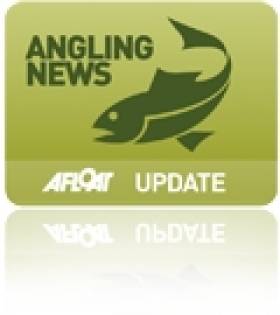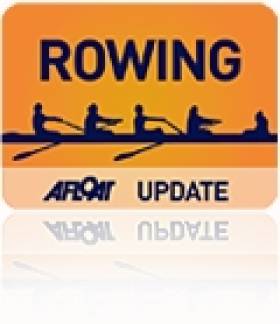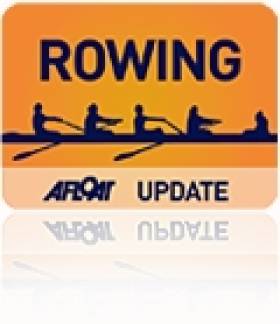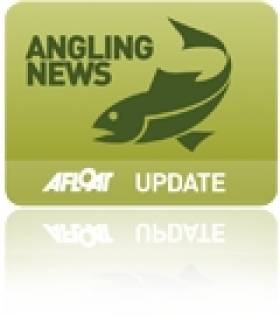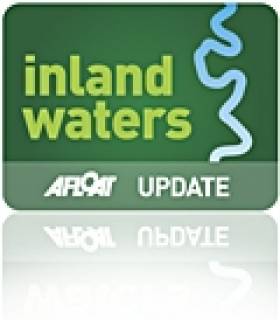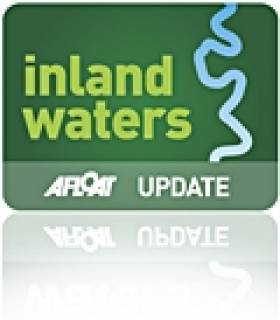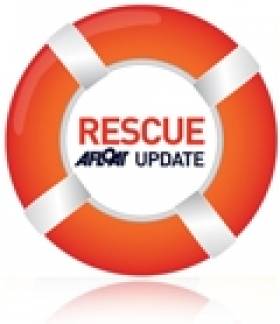Displaying items by tag: Limerick
Illustrated Talks On Shannon's Natural Heritage Throughout February
#Shannon - MulkearLIFE and Inland Fisheries Ireland have announced details of a series of free illustrated talks taking place in Limerick throughout February on the extraordinarily rich natural heritage of Ireland, and in particular the Lower Shannon.
The talks form part of MulkearLIFE’s Environmental Education Programme, an outreach programme in local schools and the local community in the Mulkear catchment. The series will be hosted over four Tuesday evenings and will include leading experts sharing their knowledge on farming and conservation and biodiversity management.
Among the talks will be the fascinating story of Atlantic salmon in the River Shannon, presented by Dr Phil McGinnity on 12 February. Dr McGinnity is Beaufort Principal Investigator with UCC’s Aquaculture & Fisheries Development Centre, with more than 23 ears of experience in fisheries science and management, and his talk will outline new and extremely exciting research on the genetic make-up of various salmon types found in the Shannon. He will also examine the history of salmon fisheries on the Shannon. His talk should be of particular interest to anglers far and wide and anyone with a general interest in Irish biodiversity.
On 19 February, Colette O’Flynn will relate the scary story of what is emerging in terms invasive non-native animals and plants arriving into Ireland's coastal and inland waterways. O’Flynn is a research officer with the National Biodiversity Data Centre in Waterford. She manages the National Invasive Species Database for Ireland, which tracks non-native invasive animals and plants in Ireland. She is involved with many European and international invasive species information networks and has been involved with invasive species policy development for the European Commission. She previously worked in various areas in biodiversity education and awareness. Her talk should be of interest to a wide variety of people, especially anglers and those with an interest in Irish wildlife and general biodiversity.
The series of illustrated talks will conclude on 26 February with a talk by Eamon Cusack on building partnerships for sustainable fisheries on the Lower Shannon. Cusack is extremely well known in the fisheries world with over 35 years experience in inland fisheries management. As the former CEO of the Shannon Regional Fisheries Board, he encountered many of the challenges facing fisheries management, and has hands-on experience of policy development, strategic management, change management, enforcement, development and rehabilitation. This talk will focus on his recent work to bring together anglers and the ESB to provide to build effective and durable partnerships for sustainable fisheries. His talk should be of particular interest to local anglers and anyone with a general interest in conservation management and planning.
But the series begins on 5 February with a talk presented by Ruairí Ó Conchúir on conservation farming and biodiversity in the Upper Mulkear Catchment. Ó Conchúir is the manager of MulkearLIFE and has worked in land care management, rural development, farming for conservation and fisheries restoration work for over 20 years, including 10 years in Southern Africa. His talk will focus on the work of MulkearLIFE with farmers over the past three years, with a particular emphasis on partnership work with farmers to improve local habitats. The talk will also attempt to map out where upland farming in Ireland is heading and review work in other uplands parts of Ireland, and outline the likely implications are for upland communities, related farming and habitats post 2014. His talk should be of particular interest to anyone with a general interest in farming, the Irish uplands and the future of EU agri-environmental supports post 2014.
The venue for all talks is the Inland Fisheries Ireland office at Ashbourne Business Park, Dock Road, Limerick. There is plenty of free parking at the front of the building at night. Talks will commence at 8pm sharp and there is free admission to all talks. Further information regarding any of the talks may be obtained from the project [email protected] or from MulkearLIFE, Inland Fisheries Ireland (Limerick) at 061 300 238 or 087 062 5582.
IFI Repeats Concerns Over Aran Islands Fish Farm
#Angling - Anglers on the River Feale in Kerry and Limerick have been assured by Inland Fisheries Ireland (IFI) that it supports their concerns over the proposed deep-sea fish farm in Galway Bay, as the Limerick Leader reports.
Local anglers are among those throughout the region who have rallied in opposition to plans for the Aran Islands fish farm project, over fears that it would lead to “an explosion” in parasitic sea lice which would prey on wild inland salmon from Irish rivers feeding in the North Atlantic.
IFI reiterated its statement issued last month in which its board said it does not believe "that the corpus of peer reviewed international scientific literature which recognises the negative impacts of sea lice on salmonids have been adequately dealt with" in the Environmental Impact Statement prepared by Bord Iascaigh Mhara (BIM) as part of the public consultation process.
A spokesperson for IFI told the Limerick Leader that the authority has "major concerns about the location and scale [of the farm], as well as its potential impact on sea life. [IFI] is not supporting it in its current form.”
Earlier this month the National Inland Fisheries Forum also criticised as "flawed" the consent process regarding the 15,000-tonne organic salmon farm planned off Inis Oirr, which would be the largest of its kind in Europe.
If approved, the operation could more than double Ireland's current production rate of farmed salmon.
The Limerick Leader has much more on the story HERE.
Good Day For St Joseph's Rowers at Castleconnell Head of the River
# ROWING: St Joseph’s of Galway had a good day at the Castleconnell/Bulls and Bears head of the river on the Shannon on Saturday. The Junior 18A eight from the school was the fastest crew and the Junior 18A quadruple also won.
Castleconnell Bulls and Bears Head of the River, Saturday (Selected Results)
Men
Eight – Junior 18A: 1 St Joseph’s 10:06, 2 St Joseph’s B 10:14, 3 Col Iognaid 10:45. Junior 16: 1 St Joseph’s 10:56, 2 St Joseph’s B 11:06, 3 Col Iognaid 11:13. Masters: Shannon C 11:42.
Four – Intermediate One, Coxed: 1 Col Iognaid 11:29, 2 Fossa 11:34, 3 St Michael’s 11:52.
Pair – Senior: 1 St Michael’s G 11:15, 2 St Michael’s E 11:19, 3 Castleconnell/Clonmel 11:36. Junior 18A: 1 Clonmel 11:59, 2 Presentation Col 12:45, 3 Commercial 12:54.
Sculling, Quadruple, coxed – Junior 18A: 1 St Joseph’s 10:14, 2 Athlone 10:48, 3 Presentation Col 10:58. Junior 16: 1 Commercial 11:24, 2 Clonmel 11:27, 3 Presentation Col 11:39.
Double – Intermediate: 1 St Michael’s 11:13, 2 Garda 11:28, 3 St Michael’s B 11:40. Junior 18A: 1 Commercial B 12:13, 2 Commercial A 12:18, 3 Presentation Col B 12:28. Junior 16: 1 Castleconnell 11:57, 2 Clonmel 12:05, Athlone 12:05.
Single – Senior: 1 Commercial (D’Estelle Roe) 12:12, 2 Commercial (Gleeson) 12:32, 3 Offaly (O’Donoghue) 13:15. Intermediate One: 1 St Michael’s (Lazda) 12:29, 2 Commercial (Yeomans) 12:30, 3 University of Limerick (Haugh) 12:34. Novice: 1 Clonmel (Murphy) 12:44, 2 Clonmel (Chadfield) 12:57, 3 Offaly (Gannon) 13:52. Junior 18A: 1 Athlone (Molloy) 12:16, 2 Commercial (Yeomans) 12:31, 3 Commercial (Yeomans) 12:37, 4 St Michael’s (Despard) 12:37. Masters: Offaly (Hussey) 13:17. Junior 16: 1 St Michael’s (O’Malley) 12:05, 2 Neptune (Flynn) 12:45, 3 St Michael’s (O’Connor) 12:49.
Women
Eight – Novice: 1 Commercial 13:29, 2 Univ of Limerick B 14:43. Junior 18A: 1 Shannon 11:36, 2 Commercial 13:11, 3 Castleconnell 13:29. Junior 16: 1 Shannon 12:40, 2 Shannon B 12:51, 3 Commercial 15:39.
Four – Novice, coxed: 1 Commercial 12:52, 2 Athlone 13:32, 3 Commercial B 16:20.
Pair – Junior: Commercial 14:45.
Sculling
Junior 16, coxed: 1 St Michael’s B 12:58, 2 Col Iognaid 13:18, 3 St Michael’s F 13:19.
Double – Junior 18A: 1 St Michael’s E 13:07, 2 Commercial 13:16, 3 Clonmel 13:43. Junior 16: 1 Col Iognaid 13:37, 2 Tralee B 13:57, 3 Offaly 14:34.
Single – Intermediate: 1 Commercial (Foley) 13:39, 2 St Michael’s (McEvoy) 13:48, 3 Garda (Holden) 14:38. Novice: 1 Commercial (Foley) 13:58, 2 Shannon (Ryan) 14:27, 3 Univ of Limerick (O’Sullivan) 14:56. Junior 18A: 1 Commercial (Rodger) 14:14, 2 St Michael’s B (Sheehan) 14:36, 3 Castleconnell (Donegan) 14:42. Junior 16: 1 Commercial (Lambe) 14:00, 2 St Michael’s (Murphy) 14:05, 3 Castleconnell (Griffin) 14:31.
Limerick Hits Mark With Well-Run World Rowing Coaches Conference
# ROWING: The World Rowing Coaches Conference in Limerick over the weekend saw Irish delegates mix with the men and women who guided crews to glory at London 2012 in a well-run event. The presentation by Thomas Poulsen of Denmark was highly-praised, and there was a thought-provoking talk by German team psychologist Dr Annelen Collatz. Gearoid Towey spoke about the importance of managing the transition of athletes to life away from top-class sport and Martin McElroy also made a presentation.
The year of the Olympic Games is a good time to hold this event and delegates got a feel of being in the engine of world rowing as top coaches and mentors thrashed out proposed changes to rules which can be made early next year. A proposal to put the onus on each athlete to reach a set weight in a lightweight boat was controversial and discussed at length on Saturday evening.
The World Rowing Awards for 2012 were presented to the South Africa lightweight four (male crew of the year) and Britain’s women’s double sculls (female crew of the year). The coach of the year was Dick Tonks of New Zealand and single sculler Huang Cheng of China took the award for adaptive crew of the year. Di Ellis was given the award for distinguished service to rowing.
At the conclusion of the business side of the event, John Boultby, the chairman of Fisa’s competitive rowing committee, said the logistical organisation in Limerick had been “superb”.
Gandelow Rowing Races Return to Limerick this October
#gandelow – The Ilen School Gandelow Races on Sunday October 28th are shaping up to be another exciting river sporting event. The races, which can be watched from the river banks, will be started from Howley's Quay adjacent to Clohessy's Bar.
This unique traditional boat sporting event has attracted 10 teams from Limerick City and County as well as County Clare. With such strong teams we can expect to see more great racing this October Weekend. The first race will start at 2.00 pm. Prize money and trophies for first and second place.
Man Prosecuted for Illegal Fishing on Mulkear River
#ANGLING - A man has been convicted and fined at Limerick District Court for illegally fishing without a permit on the Mulkear River in another successful prosecution for Inland Fisheries Ireland (IFI).
Last June, fisheries officers with IFI were carrying out a routine licence and permit patrol on the Mulkear River in the east of Co Limerick, in an area locally known as the 'Long Field'. One individual - a Mr Storan - was angling without a permit or State licence and was issued with an on-the-spot fine which had to be paid within 21 days.
The fine remained unpaid, and following several court proceedings and a bench warrant, the case was heard on 17 September and Mr Storan was convicted under Section 178 (Unauthorised entry on a several fishery). He was fined €250 and instructed to pay €400 in expenses to IFI.
IFI said: "This successful outcome was the part of the commitment of Inland Fisheries Ireland to focus on the protection of fish, especially during a time of resource constraints."
The Mulkear River is one of only two rivers which meet its salmon conservation limit in the Shannon River Basin District and angling is therefore permitted for wild salmon, subject to a licence and quota.
According to IFI, currently the river "holds excellent stocks of wild salmon, but incidents such as these are extremely detrimental and will threaten the integrity of the stocks in the river."
IFI's Limerick director Amanda Mooney commented: “This case could have been dealt with through our on-the-spot fine procedures but the individual chose to go to court where the fine was much greater.
"Inland Fisheries Ireland is committed to the protection of our wild salmon stocks and follow through on all fisheries offences.”
IFI continue to run a 24/7 hotline where anyone can report illegal fishing activity at 1890 34 74 24 or for easier recall 1850 FISH 24.
Largest Boat Rally to Arrive in Limerick this Weekend
#inland – The Largest Boat Rally to ever travel to Limerick will arrive at the Hunt Museum this weekend the 30th-1st July as part of an organised tour to Kilrush for boaters from all over the inland waterway system.
Over 80 boats are expected to take part in this momentous event as they depart in groups from 5.30am on Saturday and Sunday morning leaving Killaloe & Ballina and heading to Parteen Weir, Ardnacrusha and down into Limerick City itself.
This rally is extremely special in that many of the boaters have never made the journey through the lock and into Limerick before. This 'newbies' rally where boats travel 'in company' is designed to show inland waterway boaters the joys of travelling through Ardnascrusha and into the city and as they travel under the guidance of highly experienced boaters from the Inland Waterways Association of Ireland (IWAI) , any 'fear of the unknown' is greatly reduced.
Éanna Rowe Head of Marketing & Communications, Waterways Ireland confirmed "Waterways Ireland is delighted that the moorings in Limerick City are ready to receive such a large flotilla, as all the works have been completed over the winter in preparation for more boat traffic through Limerick. That fact that these boaters are mostly new visitors to Limerick is to be greatly welcomed. I hope their experience is highly enjoyable and that they stay longer on their next journey."
Dave Mc Cade and Noel Griffin Organisers of the Rally stated "The IWAI is delighted to be bringing this rally into Limerick, and the Open Day on Sunday 1st July is a great opportunity for local people to come down and visit us on Arthurs Quay and behind the Hunt Museum."
Limerick City Reopens to Boaters After Dredging Works
#shannon – Waterways Ireland has successfully completed dredging maintenance in Limerick City around Sarsfield Lock and the Abbey River undertaken over the Winter & Spring of 2011/12 so the city is once again open to boating traffic.
This contract was challenging due to the requirement to execute the works during the winter, out of the boating season. The Abbey River experienced very high flows at this time of year as a result of operations at Ardnacrusha Power Station and part of works were undertaken in a tidal zone of the river. Meticulous planning by Waterways Ireland and the contractor was required to ensure the dredging was carried out safely and effectively in reduced daylight hours, under strict environmental guidelines with severely limited access and traffic restrictions within the city. The contract resulted in the removal of approximately 20,000 tonnes of sediment deposits from the navigation channel in the Abbey and Shannon Rivers.
The work programme was carefully planned approximately 18 months in advance and involved extensive consultation with National Parks and Wildlife Service, Shannon Foynes Port Company, Inland Fisheries Ireland & Limerick City Council (Planning, Roads, Environment and Waste sections) to minimise the impact of the essential maintenance works on the sensitive habitats that have become established within the Shannon estuary.
Licences to undertake the work were secured in October 2011 and continual monitoring ensured that the works were carried out in full compliance with current environmental legislation. In addition the consultations developed into regular communications during the progress of the contract and also involved the local rowing clubs and city councillors.
The contract was undertaken in three phases as a result of differing site requirements and conditions. The first phase from the Custom House Quay to Sarsfield Lock was undertaken in October 2011 and required the employment of a pontoon mounted excavator with barges. Barges transported the material to Sarsfield Lock where a temporary loading area was constructed for load out to lorry.
The second phase of the contract was undertaken in December and involved the removal of material from the Baals Bridge area of the navigation. Flow conditions in the river dictated the employment an innovative amphibious excavator. Access for this excavator was achieved through the Park Canal and the existing Lock, where it was able to operate directly in the river at low tide conditions. Removal of the material was via an agreed temporary loading area at Baals Bridge
The third phase of the contract, undertaken in February involved the removal of material from the Georges Quay area of the navigation. Work in this area was undertaken last as additional environmental studies and approval was required to protect the Lamprey Eel. Flow conditions in the river dictated a different removal method that employed a smaller pontoon-mounted excavator with an anchorage system. Removal of the material was via an agreed temporary loading area at Georges Quay, immediately adjacent to the Barrington Hospital, direct to lorry and disposal.
All dredged material removed from the Abbey River was transported to a licenced disposal facility in accordance with current disposal legislation and the Traffic Management Plan agreed with Limerick City Council, which was designed to minimise traffic disruption in the city centre.
It is anticipated that this maintenance work will greatly enhance the key asset that the navigation provides to Limerick City and help stimulate greater use of the marina by boats. The improved mooring facilities will also enable the boating enthusiast to access the extensive public amenities available in the city centre, including many restaurants, bars, shops and museums amongst other attractions.
Man in Serious Condition After Falling Overboard Off Clare
Breaking News reports that the individual was seen experiencing difficulty in the sea north of Kilkee, close to Donegal Point.
The Irish Coast Guard and Kilkee Marine Rescue Service immediately mounted a rescue operation, and the man was removed from the water by rescue helicopter to Limerick's Mid Western Regional Hospital.
The man is believed to be in a serious condition.
Limerick to Host New Boatbuilding Degree Courses
A new scheme to teach traditional boatbuilding skills to university level could be of huge benefit to young people from disadvantaged areas of Limerick.
The Irish Times reports that degree programmes in traditional boat craft accredited by the UK's University of Middlesex are set to take their first students in 2012.
Minister for the Marine Simon Coveney also confirmed that partnerships have been developed with the US Northwest School of Wooden Boat-building and Sail Training International.
Some 40 trainees, mostly from Limerick's designated regeneration areas, have already taken part in the restoration of the ketch Ilen, designed by record-breaking sailor Conor O'Brien.
The AKA Ilen project, set up by boat-builder Gary McMahon, is intended to "nurture self-belief and confidence through the medium of wooden boatbuilding and maritime education".
The Irish Times has more on the story HERE.



























